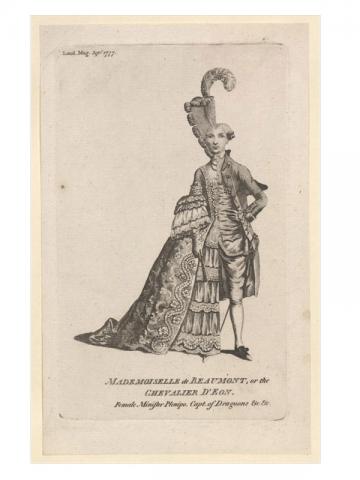Weston Library Special Collections

(c) John Johnson Collection, Bodleian Libraries
The Bodleian Libraries’ Special Collections are a treasure trove of archives, manuscripts, rare books, printed ephemera, maps and music, which date from the present day back to ancient and classical antiquity, and many were created by or of importance to LGBTQ+ people.
Some of the oldest items are 2nd century papyrus fragments of the poetry of Sappho of Lesbos. A few hundred years later, you will find the 1682 proceedings to nullify the marriage of the musician Arabella Hunt and her husband James Howard, who turned out to be a woman called Amy Poulter [MS. Rawlinson B. 378, fols. 259-67]. There is more on cross-dressing in the John Johnson Collection of Printed Ephemera, including images of the Chevalier d’Éon (1728-1810), who presented as both a man and a woman throughout a complicated and intrepid life as a diplomat and spy.
The literary archives include a number of queer writers, like William Beckford, one of the richest men in 18th century England, who exiled himself to the continent after he was found in compromising circumstances with William Courtenay, “one of the most beautiful boys in England” [MSS. Beckford]. Or how about the papers of Wilfred Owen, a leading poet of the First World War, or the archive of Stephen Spender [MSS. Spender], a friend of WH Auden and Christopher Isherwood? Less well known is Ivor Treby [MSS. Treby], a founding member of the Gay Authors’ Workshop, who spent years researching the Victorian poet ‘Michael Field’, which was the nom de plume of two potentially lesbian women. The Library houses many Michael Field amongst its collections.
There is plenty to find in the political and scientific collections as well, including the archive of computer scientist Christopher Strachey, a friend of Alan Turing [MS. Eng. misc. b. 248-302]; the archive of Roy Jenkins, the Labour Party Home Secretary who oversaw the 1967 partial decriminalisation of homosexuality in England and Wales [MSS. Roy Jenkins]; and also the archive of the Conservative Party, if you want to see how attitudes have changed over the years. And this is all just the tip of the iceberg! There is plenty more to see.
Some of the finest manuscripts can be seen in the free-to-visit Treasury Gallery in the Weston Library and online. You are also welcome to do your own research in the Weston. For more information, including how to get a reader’s card (free for Weston Library researchers), please see the Weston Library website.
Location: Broad Street, Oxford, OX1 3BG
Blackwell Hall open: 8:30am-5pm Monday to Friday, 9am-5pm Saturday, 11am-5pm Sunday
Exhibition galleries open: 10am-5pm Monday to Saturday, 11am-5pm Sunday
Admission into Blackwell Hall and exhibition galleries is free